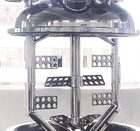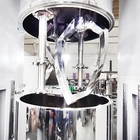Integrating development, manufacturing and sales, as a first-level mixer emulsifier factory.
Top 5 Mistakes to Avoid When Buying a Filling Machine: Evaluation Process Mistakes
There are many types of filling machines, each designed to meet specific requirements based on the product and the industry. Choosing the right one can feel overwhelming given the wide range of options available. But once you clearly define your needs, the decision becomes much easier. Still, even when you know what you're looking for, it's easy to make mistakes that can impact your production in the long run.
We’re now at the fourth point in our series, which you can read alongside our article on Vendor and Support-Related Mistakes. In this edition, we’ll walk you through some of the most common Evaluation Process Mistakes people make when buying a filling machine. As always, these points are explained in a simple and practical way, to help you avoid costly errors. If you need more detailed advice or have specific questions, feel free to reach out via email or WhatsApp.
Choosing the right filling machine is more than just comparing technical specifications and price tags. It requires a careful evaluation process that considers your real-world operations, product characteristics, and long-term production needs. Unfortunately, many businesses make critical mistakes during this phase—mistakes that can lead to inefficiencies, product issues, and avoidable downtime.
Below are some of the most common evaluation mistakes, and how to avoid them:
Not Getting a Custom or Tailored Solution
Choosing an “off-the-shelf” filling machine might seem simple—especially if it's marketed as a one-size-fits-all solution. This can work for very basic operations, but keep in mind that your product or production line may require specific features, as we discussed in our article on technical mistakes and will present in the article on operational and capacity-related mistakes.
Here’s why a generic solution can be problematic:
- Your product may have unique characteristics, such as viscosity, temperature sensitivity, or foaming.
- Your packaging might require special handling (e.g., fragile bottles, narrow necks, or multiple sizes).
- Your production layout may not match a standard machine’s footprint or flow.
To ensure your machine meets your specific needs, you should:
- Work with a supplier who is willing to customize settings, nozzle designs, conveyor configurations, or automation levels.
- Provide product samples and packaging materials during the evaluation phase to allow for realistic testing.
- Ask the supplier if they have experience with similar industries or product types.
A tailored solution leads to better integration and long-term performance. But even with all these customizations in place, you still haven’t seen how the machine actually works—bringing us to the second mistake.
Skipping a Live Demo or Trial Run
Approving a machine without seeing it run—especially with your own product—can lead to several unexpected issues:
- What looks good on paper might not perform well in practice.
- You may face problems such as splashing, spillage, inaccurate filling, or slower-than-expected speeds.
- You won’t get a clear sense of how user-friendly the machine really is for your team.
To avoid surprises, request the following from your supplier:
- A live demonstration, either in person or via video, ideally using your actual product and containers.
- Performance data during the demo (e.g., fill speed, accuracy, changeover time).
- A video demonstration showing how to clean, maintain, or adjust the machine.
A live demo is the best way to validate performance claims and ensure you're getting what you expect. But don’t evaluate the machine alone—making decisions in isolation leads to the next mistake.
Failing to Involve Key Stakeholders
While the previous two mistakes involve external issues, this one is internal—and it often happens during the evaluation stage. Leaving the decision entirely to purchasing or management, without input from the people who will use or maintain the equipment, can create long-term problems:
- Operators may struggle with unfamiliar controls or an inconvenient layout.
- Maintenance teams might lack the tools or knowledge to service the machine properly.
- Quality assurance may face challenges with consistency or hygiene compliance.
To ensure a smooth rollout, make sure to:
- Involve production managers, line operators, maintenance technicians, and QA staff during evaluation and demo phases.
- Ask each team to review the machine from their perspective and raise any concerns.
- Use their feedback to uncover potential issues early, before making a commitment.
By including all relevant departments, you help ensure smooth adoption and fewer complications after installation.
Final Thoughts
The evaluation phase is your best opportunity to avoid buyer’s remorse. A thorough and collaborative process—focused on customization, real-world testing, and cross-functional input—can save your company time, money, and stress down the line.
Before signing any deal, ask yourself:
“Does this machine fit our process—or are we adjusting our process to fit the machine?”
The right vendor will help you answer that question honestly.














































































































